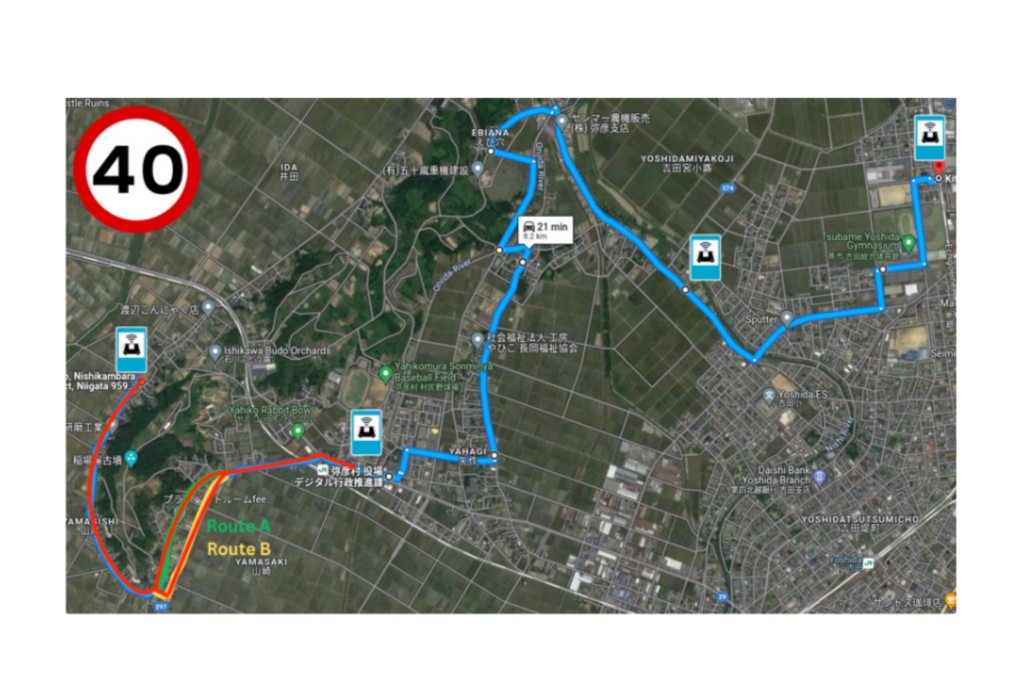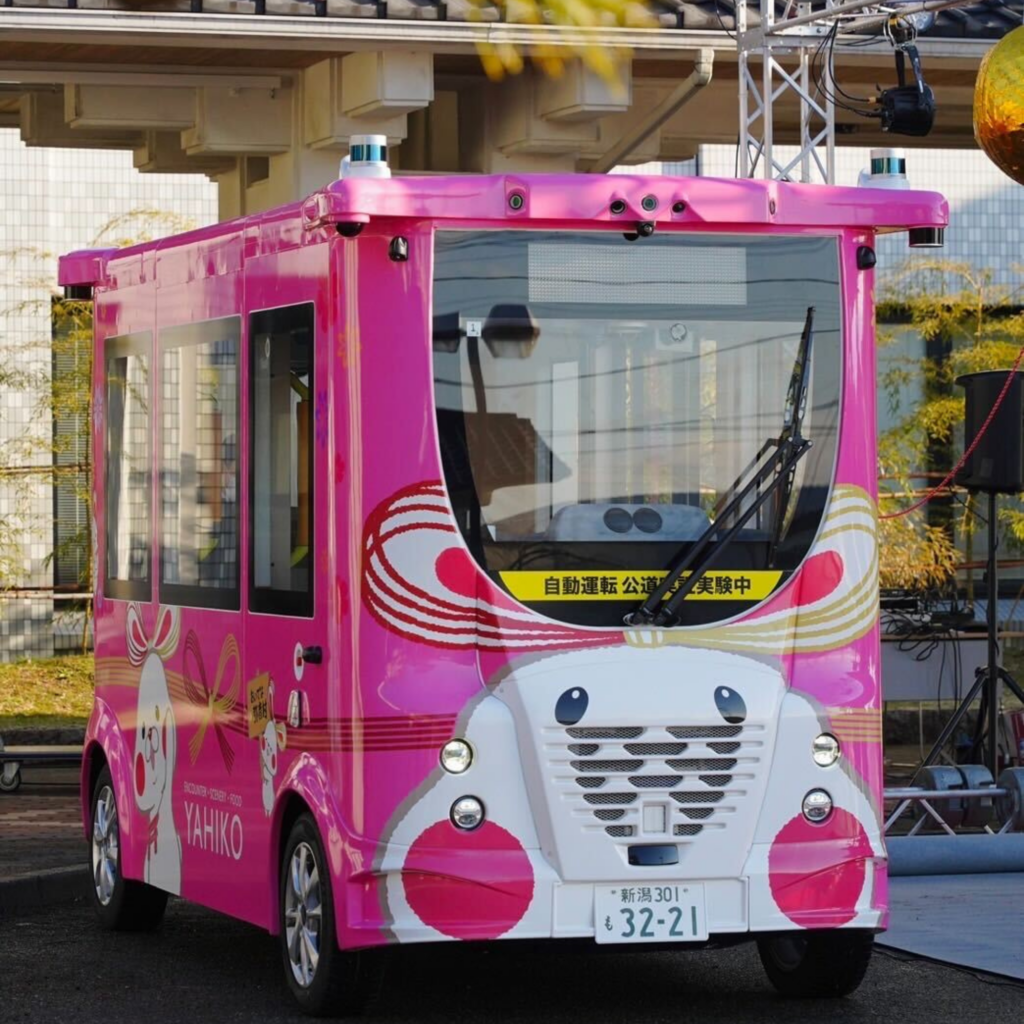Autonomous Bus Revolution: How Auve Tech Buses Transform Mobility in Yahiko

Project Overview
Auve Tech’s autonomous bus has been deployed in Yahiko, Japan, as part of a groundbreaking project aimed at addressing rural transportation challenges. By integrating cutting-edge autonomous technology into scheduled public transport, the project seeks to enhance mobility for underserved demographics, particularly the elderly.

Operating Environment and Challenges
Yahiko’s autonomous bus MiCa deployment operates in a rural, mixed-traffic environment, posing unique challenges and opportunities for innovation. The project aims to tackle mobility issues for underserved residents while demonstrating the adaptability of autonomous technology in real-world conditions.
Operating Environment:
- Route Length: 5.5 km (one-way), connecting the city hall and train station.
- Traffic Conditions: Mixed traffic with open roads and moderate vehicle flow.
- Key Features:
- 5 main road intersections
- 2 give-way intersections
- 4 pedestrian crossings
- No traffic lights or speed bumps
- Road Conditions:
- Narrow roads requiring precise navigation.
- Seasonal weather, including snow, creating operational challenges.
- Speed:
- Speed limit: 40 km/h
- MiCa’s maximum speed: 20 km/h
Challenges:
- Mobility Gap:
- Elderly residents face limited access to transportation.
- Traditional public transport is scarce and inefficient in rural areas.
- Driver Shortages:
- Rural areas struggle to maintain public transportation services due to a lack of drivers.
- Accessibility Challenges:
- Low-visibility intersections and narrow roads require adaptable solutions.
- Environmental Needs:
- A sustainable, low-emission alternative to traditional transport options.
This environment and set of challenges make Yahiko an ideal testing ground for showcasing the reliability, safety, and efficiency of Auve Tech’s autonomous buses.

Goals and Solutions
Goals:
- Enhance Mobility for Elderly Residents:
- Provide a reliable and efficient public transportation option for elderly citizens in rural Yahiko.
- Ensure easy access to essential locations, such as the city hall and train station.
- Address Driver Shortages:
- Reduce dependency on human drivers by implementing autonomous technology in scheduled public transport.
- Improve Public Transport Efficiency:
- Create a sustainable and scalable transport system tailored for rural environments.
- Optimize routes and schedules to serve low-traffic areas effectively.
- Demonstrate Autonomous Capabilities:
- Showcase the reliability of Auve Tech’s MiCa autonomous buses in mixed-traffic, rural, and snowy conditions.
- Establish Yahiko as a model for future rural autonomous mobility projects.
Solutions:
- Deployment of MiCa Autonomous Buses:
- Utilization of two MiCa vehicles for scheduled and on-demand transport.
- Integration of teleoperation for added safety at low-visibility intersections.
- Optimized Route Design:
- A 5.5 km route connecting key locations with strategically placed bus stops.
- Safe and precise navigation through narrow roads and rural terrain.
- Adaptation to Rural Needs:
- Low-speed autonomous buses (max 20 km/h) tailored for rural road conditions and traffic.
- Continuous operation in mixed traffic and challenging weather, such as snow.
- Community-Centered Focus:
- Providing essential mobility to underserved populations while fostering inclusivity and accessibility.
- Demonstrating how autonomous buses can bridge the gap in regions lacking traditional public transport services.

Execution Stages
- Planning and Preparation:
- Designed a 5.5 km route connecting Yahiko’s city hall and train station.
- Customized MiCa buses for low-speed rural operations and integrated teleoperation for safety.
- Stakeholder Collaboration:
- Partnered with Boldly for local operations and engaged the community to meet mobility needs.
- Infrastructure Setup:
- Established bus stops and a dedicated vehicle storage facility.
- Testing Phase:
- Conducted route testing and trial runs in snowy and mixed-traffic conditions.
- Launch:
- Began operations 29th January 2024 with scheduled and on-demand services.
- Ongoing Optimization:
- Monitored performance, gathered feedback, and improved route efficiency and safety.

Challenges and Outcomes
Challenges
- Navigating Diverse Road Conditions:
- Yahiko’s route included narrow, rural roads and required autonomous navigation around pedestrians, cyclists, and other vehicles.
- Wet roads due to seasonal weather added complexity to the deployment.
- Technology Adoption:
- Introducing a new, autonomous public transport system to a predominantly elderly population posed challenges in gaining trust and acceptance.
- Infrastructure Limitations:
- The lack of advanced infrastructure such as traffic lights and speed bumps required the buses to adapt and rely on their autonomous systems for efficient and safe operation.
- Operational Visibility:
- A critical intersection with low visibility presented safety concerns, necessitating advanced solutions to prevent incidents.
Quantitative Outcomes
- Passenger Impact: Thousands of passengers, 90% of whom rated the service highly.
- Performance Metrics: Maintained 18 km/h average speed; interventions needed only in 5% of intersections.
- Environmental Benefit: Reduced emissions with electric buses.
Qualitative Outcomes
- Improved Accessibility: Elderly residents gained easier access to key locations.
- Community Trust: Engagement and trials built confidence in autonomous technology.
- Global Scalability: Proven viability for rural deployment with minimal infrastructure.
- Operational Reliability: Adapted well to road challenges and weather conditions.
Lessons Learned
- Adaptability in Rural Settings:
- Autonomous buses can effectively navigate rural roads, low-visibility intersections, and mixed-traffic environments with minimal manual intervention, proving their adaptability.
- Community Engagement is Key:
- Building trust through trial runs and communication with local residents was critical to the project’s acceptance and success.
- Teleoperation as a Safety Net:
- Teleoperation proved essential for managing challenging intersections and ensuring safe operation, highlighting its importance in similar deployments.
- Scalability Opportunities:
- The Yahiko project demonstrated that autonomous buses could address public transportation challenges in underserved areas worldwide, offering a scalable solution for rural mobility.
- Weather Preparedness:
- Operating in wet and snowy conditions showed the importance of rigorous testing and vehicle adaptation for challenging weather environments.
Conclusion
The Yahiko autonomous bus project has set a benchmark for rural mobility solutions, showcasing the capabilities of Auve Tech’s MiCa buses to provide reliable, safe, and environmentally friendly public transport. By overcoming road, weather, and infrastructure challenges, the project improved access for elderly residents while demonstrating the scalability of autonomous systems in rural environments. This success reinforces Auve Tech’s commitment to revolutionizing transportation and paving the way for future deployments in similar settings.
Contact Us
For more information about the Yahiko project or to explore how Auve Tech can bring autonomous mobility solutions to your region, contact us today: hello@auve.tech
